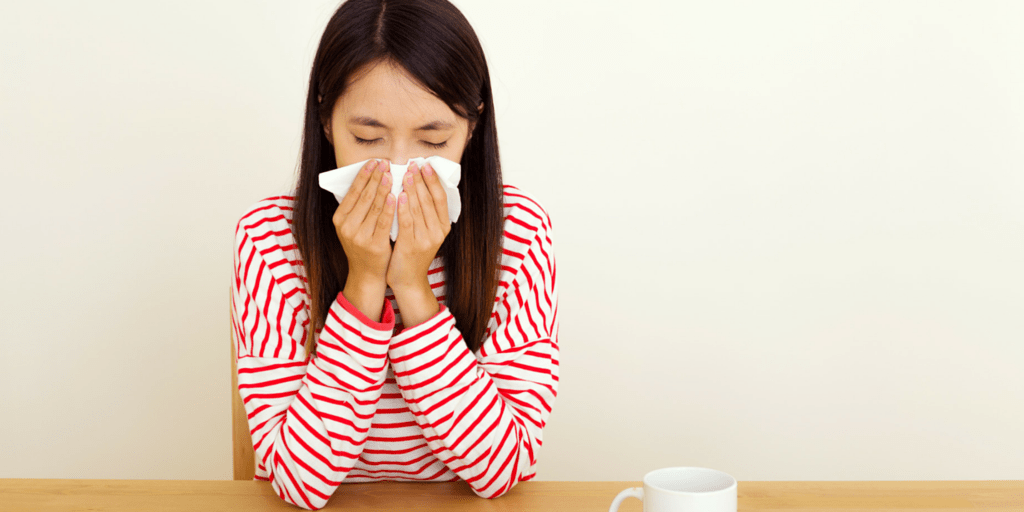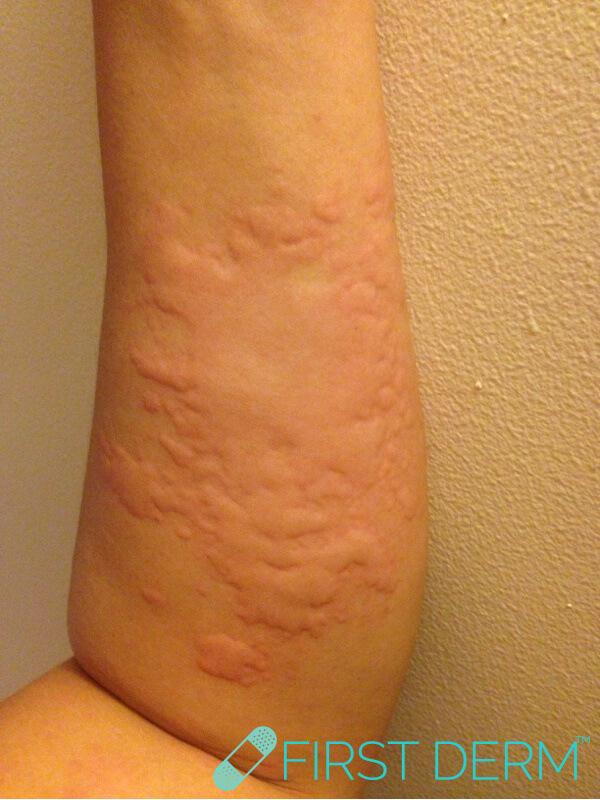Skin Allergies: Everything You Need To Know
Welcome to our comprehensive guide on all things skin allergies. We see a lot of them here at First Derm so we’re hoping we can help you with this guide. Remember if you’re unsure about a rash or spot you can speak to us anytime.
If you prefer to jump to a section of our guide click the link here:
- Why Do I Suddenly Have Allergies?
- How Allergies Affect The Skin
- Top 5 Skin Allergy Causes
- Are Skin Allergies Permanent?
- Skin Allergy Diagnosis
How Do Allergies Work
One of the most frustrating things about allergies is how little sense they seem to make. For example, It’s fairly obvious why hazardous materials or infections cause your skin to react. However, why should common foods and environmental triggers do the same?
What Allergens Do to the Body
Allergy and illness symptoms have a lot in common because they’re both caused by the immune system. Take hives, for example: simply put, hives are typically caused by a reaction in the skin that causes it to inflame or swell. This reaction occurs when the immune system is fighting off an invader.
When you get hives from an infection, it’s a sign that your immune system is working to get you healthy again. An allergen is a normally harmless substance – such as peanuts or pollen – that causes certain people’s immune systems to go haywire.
When someone with a peanut allergy comes in contact with peanuts, their immune system thinks the peanut proteins are threats and launches a counterattack. Depending on the allergy, this counterattack can range from a mild skin rash to a life-threatening reaction.
How Allergens Work Together
It’s a common mistake to think that you’re only allergic to one thing. In reality, most people are allergic to several different allergens. If you are allergic to multiple allergens, you may notice symptoms only when you’re exposed to several of your allergens in a short period of time.
As an example, let’s imagine a person who’s allergic dust mites, latex and pollen. In a single morning, that person could encounter dust mites in bed, eat some latex-related fruits for breakfast, and get some pollen on the skin as they leave the house.
In their immune system, these allergens add up and eventually cause symptoms. In this story, the person might assume they’re allergic to the most obvious thing – pollen. In reality, though, the dust mites and fruits are playing an equally important part.
So Why Do I Suddenly Have Allergies?
Mostly this is due to allergies working together as mentioned above. However, another common mistake people make is to think that allergies remain the same throughout a person’s life. In reality, most people’s allergic triggers (and their allergic reactions) change over time.
Many people experience food allergies as children and then grow out of them as they get older. On the other hand, many young adults develop sensitivities to environmental allergens (such as pollen) as they age. There are also some people with allergies that remain the same throughout their lives. Even though they’re well-known, their cases are not necessarily the norm.
New allergies can appear in several different ways, with respiratory and skin symptoms among the most common. If you’ve had a sudden breakout of hives or eczema, a newly developed skin allergy could be the cause. To find out what’s going on, we recommend having an online dermatologist or doctor look at it.
How Allergies Affect The Skin
Whilst we know that allergies can come on suddenly and may change throughout our life. One thing we don’t expect is for them to affect the skin.
Let’s be honest, most of us think of runny noses and watery eyes when thinking of allergies, but there are actually a lot of other ways that allergy can affect the body. In addition to common hay fever symptoms, it’s also possible for allergy symptoms to appear on the skin. When these skin symptoms appear alone – without the “classic” allergy symptoms – many people don’t realize that an allergy is causing them. This misunderstanding can lead them to choose the wrong treatments, which makes it harder to get relief.
There are several common skin conditions that are sometimes (but not always!) caused by an allergy. Two of the most common are explained below. If you’re suffering from either of these conditions, it would be a good idea to consider allergy as a potential cause!
Hives
As mentioned previously, hives normally appear as red itchy bumps on the skin. The bumps can also burn or sting in some cases. Most hives breakouts last between a couple hours and a day. Some breakouts last days or weeks, but those cases are typically not caused by allergy.
Many people think that allergens need to touch their skin to cause a hives breakout, but it’s also possible to get hives by ingesting one of your allergens (such as peanuts or dairy). If you experienced an outbreak of hives after eating or touching something new, it’s very possible that an allergy was the cause.
Eczema
Eczema’s defining symptom is patches of dry and itchy skin on the hands, face, neck, elbows or knees. Eczema can also affect other parts of the body, but those areas are the most common.
Eczema and allergies are very closely linked. The likelihood that your eczema is allergy related increases significantly if you also suffer from seasonal allergies, food allergies or asthma. Even if you don’t have these other conditions, it’s still worth investigating a potential allergy.
Our View On Skin Allergies
Knowing your allergens is especially important if your skin condition appeared out of nowhere. Surprise symptoms can be hints that your allergies are changing. If your allergies are becoming more severe, then knowing exactly what you’re allergic to can help you avoid your triggers and prevent potentially dangerous allergic reactions.
Top 5 Skin Allergy Causes
So let’s recap. We know that:
- Allergens can build up and combine with other allergens
- They can come on suddenly throughout our life
- They can often appear in the skin through hives and eczema
So, our next question is, what are the worst allergens for affects on the skin?
1. Ragweed Pollen – Public Enemy No. 1
It makes our vegetables grow and flowers bloom. For those of us unlucky enough to be seasonal allergy sufferers, pollen can also cause little red bumps to appear all over our skin. There are many ways that you can come into contact with pollen, whether it’s pets, plants, or just being outdoors. If you are allergic and do come into contact with pollen those familiar little red, itchy bumps, also known as Contact Dermatitis will be around for a couple days. To help with symptoms try applying a cold compress and take an antihistamine to help relieve the itching. Just remember, DON’T SCRATCH.
2. Mold
Mold is gross. Spring and Summer provide the perfect time for mold spores to reproduce – even more gross. With the damp and humid conditions that are synonymous with springtime, mold thrives. Mold can cause a variety of health conditions if you are exposed to it but most of us are only familiar with the respiratory effects it can have on us. What you may not know is that seasonal mold can also cause those little red bumps, Contact Dermatitis to appear.
3. Grass
Spring and summer bring us green grass. This is much more aesthetically pleasing than dead grass, but the allergy sufferers among us may just want to see it burn. Grass pollen is one of the most common pollens and can cause anything from a small rash to severe welts and hives. Avoiding these terrible side effects of the allergy is easy (but not fun). It involves staying away from grass. However, if you’re like us and can’t stay away, there are some simple solutions:
- Sitting on a blanket
- Wearing shoes or long pants,
- Minimize your contact with grass.
Dr. Dennis Porto from First Derm explains: “pollen, mold, and grass are more likely to cause things like a runny nose and itchy eyes rather than a rash. However, some people with seasonal allergies can get swollen eyes and a red nose from sniffling and sneezing. This is a sign that you should treat your seasonal allergies with things like oral anti-histamines.”
4. Bees
As plants begin to bloom the bees are close to follow. If you are not severely allergic there are some less serious side effects that a bee sting will cause. These include, hives, swelling, itching, redness and swelling around the site of the sting. There’s not a whole lot we can do to avoid bees, besides not going outside. Just remember if you do encounter a bee to remain calm and walk away.
Dr. Porto describes that “bee stings for the non-allergic patient are almost never worrisome. However, if you start to get short of breath, notice that you lips or tongue are swelling, or feel generally unwell, a trip to the ER would be prudent to rule out possible anaphylaxis.”
5. Pet Dander
Spring and summer are when Fido sheds his winter coat, and unless you are lucky enough to have a hypoallergenic dog this can cause some adverse skin reactions. Depending on the severity of your allergy this can cause and hives, rashes, or those small red bumps. To help counter this problem brush your dog outside and vacuum often to reduce indoor dander. “As with any contact dermatitis,” explains Dr. Porto, “limiting exposure is the first line treatment. For very mild cases, over the counter products like Benadryl and Hydrocortisone can be effective. More involved contact dermatitis will require treatment by a dermatologist, or rarely, a trip to the ER.
Are Skin Allergies Permanent?
Now we know that allergies can change throughout a person’s life. As mentioned earlier in this post, everyone can name a friend that suddenly developed a pollen allergy. Or even knows a child who grew out of a milk allergy as they aged.
Skin allergies are no exception. However, if an allergy comes on, does this mean it’s permanent?
Developing a new allergy (or growing out of an old one) is possible, but the concept is more complicated than you might think. Sometimes it can seem like your allergies have changed, when in reality they haven’t.
The Allergic March
It is possible for allergies to change over time, but these changes most often occur for children. It’s very rare for it to happen to adults.
Perhaps the best known example of how allergies can change over time is called the “allergic march” As children with allergies get older, it’s common for them to go through series of changing symptoms as they age. In most cases, the allergic march starts with skin symptoms (such as eczema) and finishes with respiratory symptoms (like hay fever and asthma).
The allergic march is a very common model for how allergies progress over time, but it’s by no means the only one. Some people experience something like the allergic march at a different period in their lives, or only experience a part of it. It’s even possible for someone’s allergies to develop in the complete opposite direction of the allergic march.
Skin Allergy Diagnosis
Allergic reactions can be confusing for sufferers. One time a rash can be mild and the next time it’s severe.
To help them make a proper diagnosis, doctors often use skin or blood testing to measure allergic reactions. These tests are important because they can identify all the allergens that a person is sensitized to. Many people believe they’re only sensitized to a single allergen: pollen, for example. However, the reality is that most people with allergies are sensitized to many different allergens.
These allergens work together to cause a reaction, and a reaction only occurs once a certain level of total allergen is reached.
To make this more clear, imagine someone who’s allergic to dust mites, dogs and pollen. They have a dog and dust mites in their house, but not enough to trigger an allergic reaction. However, once they step outside and encounter some pollen, they reach an allergen level high enough for a reaction to occur. This person might think that the pollen alone is causing reaction, but the truth is that there are many other allergens involved.
Get Checked
Allergies can be confusing and difficult to track. In these cases we recommend speaking to our online dermatologists about your concern. They can check your rash and provide feedback on your skin concerns.
Ask a Dermatologist
Anonymous, fast and secure!

The Specialist doctor from the University Hospital in Gothenburg, alumnus UC Berkeley. My doctoral dissertation is about Digital Health and I have published 5 scientific articles in teledermatology and artificial intelligence and others.








